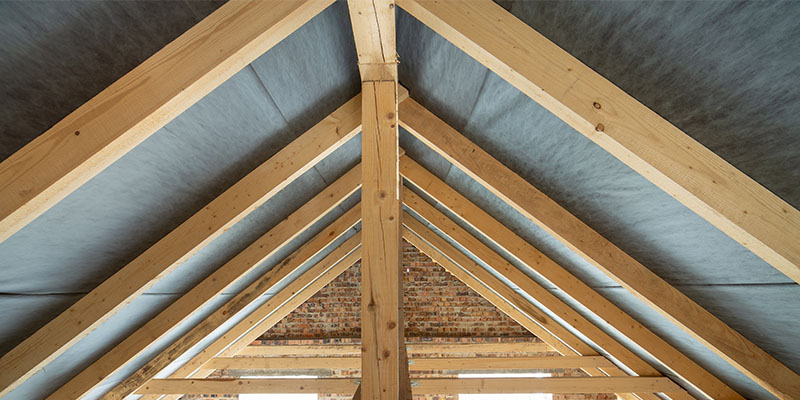
What is the Best Insulation for my Roof?
Did you know that you can conserve up to 30% of energy lost through your roof by investing in roof insulation? Millions of homes across the UK have insulation in their roofs, however, how effective is it? Homeowners should make sure that they utilise their insulation by making sure it is doing the correct job. Your roof insulation should be saving you money every month on your energy bills. Your roof insulation should also be making your home warmer and more comfortable. Additionally, your roof insulation should be reducing your carbon footprint every month. If you are not experiencing these benefits, then maybe, you need to consider alternative products of insulating your home. So, what are the best types of insulation for your roof?
1. Spray Foam Roof Insulation
Spray foam, the holy grail of insulation. This product is one of, if not the most, effective method to insulate your roof with. This foam solution is sprayed into areas needed for insulation and expands into all cracks and crevices. The spray foam solution as known properties for soundproofing, thermal insulation, eco-friendly and more.
This product is available in two different forms, open-cell foam insulation and closed-cell foam insulation. The latter, being denser, has superior thermal properties, due to its closed-cell specifications. On the other hand, the open-cell foam insulation is light, more flexible, and great for soundproofing areas.
Spray Foam Pros
Expansive - This product rapidly expands when sprayed onto a surface, this material allows for the product to expand into the smallest of gaps and holes, effectively insulating your area in need.
Eco-Friendly – Our Icynene spray foam insulation product contains recycled plastics, and the manufacturers are also devoted to planting trees with each sale they make on their closed-cell insulation drums. Additionally, by insulating with spray foam, you will reduce your energy consumption, due to the thermal insulation provided by the product.
Soundproofing – Open-cell foam has great soundproofing properties due to the open-cell structure of the product. These sound-trapping capabilities can provide you with the peace you are looking for in your home.
Save Money – By reducing your reliance on energy consumption, you will also be saving money on your energy bills every month. With estimated savings of up to 30% a month.
Durable - Spray foam, unlike other products, is extremely long-lasting. The estimated lifespan of spray foam insulation is around the same as your property and it will never lose its shape when applied.
Spray Foam Cons
Requires a Professional – Due to the substances used and the application process of spray foam insulation, it does require hiring a professional to effectively insulate your roof. If you wish to reap the benefits of using spray foam, we recommend hiring an expert in roof insulation.
Higher Costs – Compared to other roof insulation solutions, spray foam is on the higher end of them. Although, you save money every month by having your roof insulation installed, the upfront costs of using spray foam insulation are slightly higher than some other products.
2. Batt Insulation for your Roof
Batt insulation is probably the most common type of insulation found in roofs. It is one of the older used products and has always been frequently used to insulate roof areas. Batt insulation rolls are usually made up of fibreglass, but it is also common to use mineral wool insulation batts. They are DIY friendly, easy to transport and come in a variety of sizes.
Pros of Batt Insulation
DIY Friendly – Batt rolls are available in many different sizes, making it easy to find a custom fit for your roof area. This insulation is also readily available to be fitted, allowing for ease of installation into most ceiling joists and rafters.
Inexpensive – Fibreglass batt roll insulation is one of the cheaper insulation products available on the market.
Moisture Control – Batt insulation is a good protector against moisture and can work very well in homes that are subject to a lot of humidity.
Cons of Batt Insulation
Safety – While batt insulation is DIY friendly, there are safety precautions you must take. Glass fibres can easily irritate your eyes and skin and, in the worst case scenario, cause lung damage. It is extremely important that you wear protective clothing and gear before you attempt to insulate yourselves. Please contact one of our professionals if you are unsure.
Low Energy Efficiency – The thermal capacity of batt insulation is not pretty mediocre and the insulation will not perform as well as others in colder temperatures, it may require additional layers to get that thermal capacity that you are looking for.
Not Eco-Friendly – The products of batt insulation require excess energy, contributing to more air pollution than other roof insulants available.
3. Loose-Fill Roof Insulation
Loose-fill roof insulation is available using fibreglass or cellulose insulation. These products are blown-in to the areas of your roof, helping to insulate hard to reach crevices. Additionally, the above insulation options are produced from recycled waste materials making them eco-friendly products to insulate your roof with.
Loose-Fill Pros
Eco Friendly - The insulation is produced from loose fibres of recycled materials, making them an eco-friendly option for your roof insulation.
Non-Flammable – Blown-in fibre glass insulation is a fire-resistant solution for your roof. However, cellulose, composed of recycled paper, is not fire-resistant.
Durable - Blown-in cellulose insulation does not degrade over time in extreme temperatures, this can be beneficial to homeowners in colder climates.
Blown-in Insulation Cons
Health Risk – Small fibres in fibreglass present a health risk to homeowners, which can irritate skin and cause lung damage if inhaled. Protective gear is a necessity when handling fibreglass.
Fibreglass Thermal Issues - In extremely cold temperatures, blown-in fibreglass insulation can lose up to 50% of its thermal effectiveness.
Cellulose Flammable – Cellulose is a flammable product due to its paper composition and it can be difficult to extinguish.


